Muslim Population Growth and Its Global Impact
India’s Population Reaches 1 Billion (2000)
On May 11, 2000, India celebrated a significant demographic milestone as its population reached the 1 billion mark, an event symbolized by the birth of Astha Arora, declared India’s billionth baby. This landmark not only underscores a crucial point in India’s demographic history but also sets the stage for a deeper exploration into how these numbers have shaped the socio-economic and cultural landscapes of the nation. The evolution of the demographic landscape, especially concerning the growth of the Muslim population, continues to spark extensive debate and analysis, reflecting the complex interplay of cultural and religious diversity within India. Let’s delve into the historical data to further understand these dynamic changes.
This graph provides a comparative analysis of the percentage growth in the populations of Bangladesh, India, and Pakistan from 1951 to 2011. It visually represents the demographic changes in these countries over six decades, highlighting the differential growth patterns and setting the stage for a deeper understanding of regional demographic dynamics.
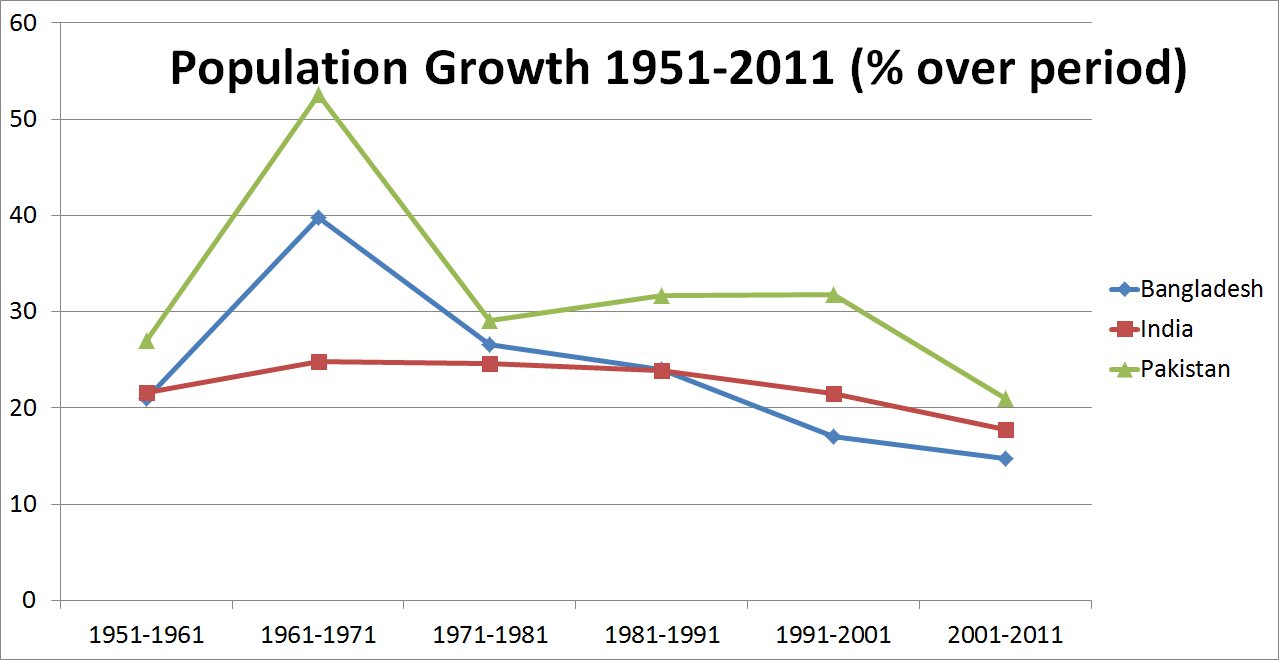
In the 19th week of 2024, this topic has resurfaced amidst election season, spurred by a recent report from the Association of Religion Data Archive (ARDA) examining global demographic trends between 1950 and 2015. According to this report, the Muslim population in India has increased by 43.15 percent, from 9.84 percent to 14.09 percent, while the Hindu population’s share decreased by 7.82 percent, from 84.68 percent to 78.06 percent. These statistics have ignited heated discussions, with various media outlets and political entities weighing in on the implications of such demographic changes.
As part of our weekly blog schedule, this Thursday’s focus is on how Hindu beliefs and practices intersect with contemporary issues, including interfaith relations and the challenges posed by changing demographics. This blog aims to explore the broader socio-political implications of India’s population growth, the factors driving demographic shifts, and the complex interplay between religious identity and modern societal challenges. In doing so, it will address misconceptions, provide a nuanced analysis of the data and reflect on the future trajectories of India’s diverse communities.
This milestone not only marks a numerical threshold but also sets the stage for a deeper exploration into how such figures have evolved over the decades, particularly through the lens of religious demographics. Let’s delve into the historical data to better understand these changes.
Demographic Analysis in South Asia Impacting Global Population Growth
To fully appreciate the current demographic dynamics, it is essential to look back at the historical population growth trends from 1951 to 2011. This period highlights significant changes in the populations of Bangladesh, India, and Pakistan, providing a foundational understanding of the forces that have shaped the current demographic landscape.
Evolution of Demographics in South Asia
This graph illustrates the demographic changes in Pakistan from 1951 to 2011, focusing on the percentage growth of the total population, Hindus, and Muslims. It offers insights into the changing religious composition of Pakistan, providing a basis for discussions on socio-political impacts and policy considerations.
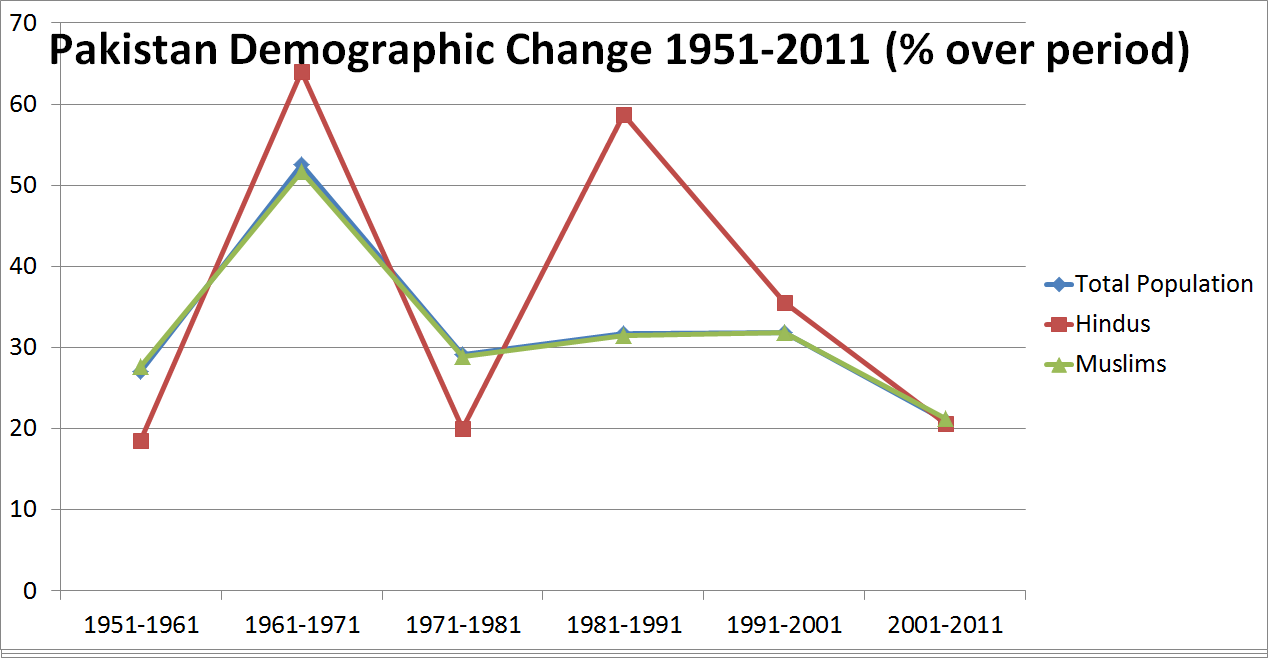
From 1951 to 2021, South Asia has witnessed profound demographic transformations, reflected distinctly in the World Population Statistics of India, Pakistan, and Bangladesh. Each country has navigated its path shaped by historical, political, and socio-cultural factors influencing their population dynamics.
Reevaluating India’s Demographic Shifts: A Focus on Population Growth from 1951-2011
As we delve deeper into the patterns of India’s demographic evolution over sixty years, it becomes evident that the forces driving population growth extend beyond conventional socioeconomic factors. This comprehensive overview is visualized through a detailed graph that outlines the percentage growth of India’s total population, segmented by major religious communities, from 1951 to 2011.
Varying Population Growths Among Various demographies
The following graph provides a clear visual representation of the demographic changes within India’s Hindu, Muslim, and other religious communities over six decades. It highlights not just the growth, but the rate at which these populations have expanded, offering insights into the dynamic interplay of cultural, regional, and religious factors that influence these trends.
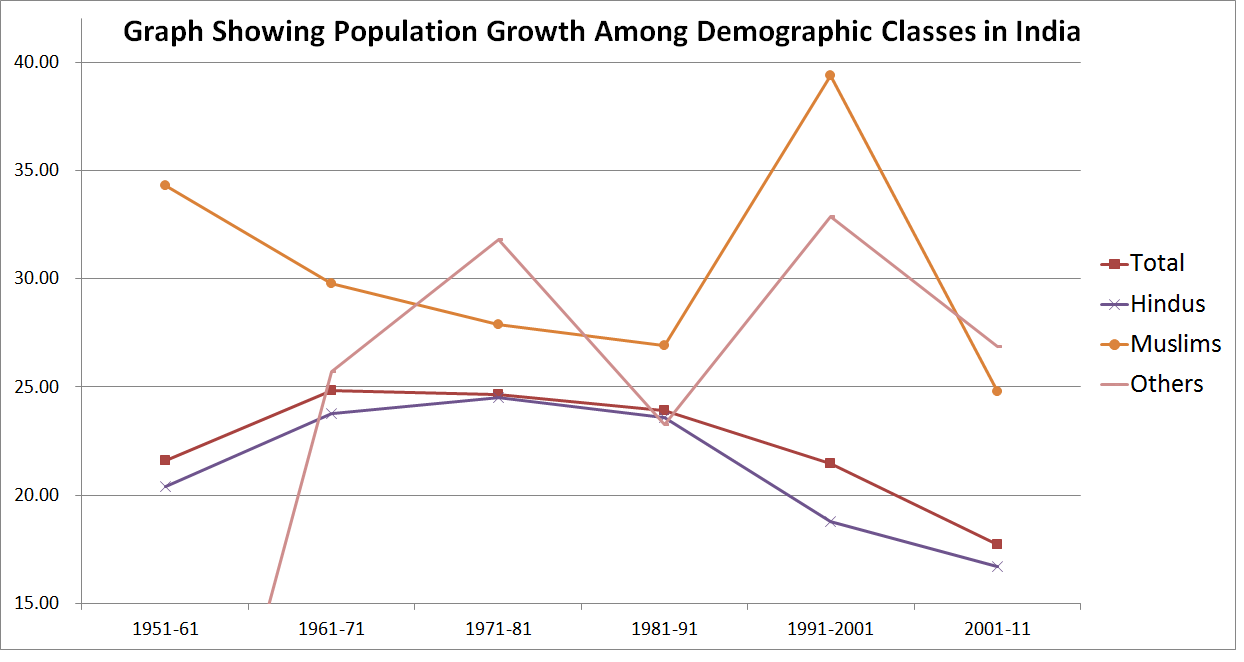
Detailed Analysis:
Overall Trends: The graph illustrates that while India’s total population has consistently grown, the rate of growth among different communities shows notable variations. Initially, all segments followed a relatively parallel trajectory. However, post-1980, the Muslim population exhibits a significant increase in growth rate, particularly between 1991 and 2001.
Hindu Population Trends: The growth rate of the Hindu population, although increasing in absolute terms, shows a declining trend percentage-wise. This suggests stabilization within the community that might be influenced by a combination of improved economic conditions, access to education, and family planning initiatives.
Muslim Population Surge: The spike in the growth rate of the Muslim population during the 1991-2001 decade stands out distinctly. This surge is not solely explainable by socioeconomic factors, which were relatively uniform across communities. Instead, it points towards a complex blend of higher fertility rates possibly encouraged by cultural norms and religious teachings specific to the community.
Other Communities: The “Others” category, representing smaller religious groups, shows the most stability but follows a slow decline in growth rate, mirroring national trends towards smaller family sizes.
Conclusions Drawn:
The diverging growth rates among India’s religious communities challenge the simplistic narrative that population growth is driven primarily by socioeconomic status. Instead, these trends underscore the significant impact of cultural and religious influences, as well as regional diversity in shaping demographic outcomes. The pronounced growth in the Muslim population, in particular, invites further exploration into how religious beliefs and cultural practices influence reproductive behaviors and family size.
This analysis not only aids in a better understanding of India’s demographic shifts but also highlights the necessity for nuanced policy-making that considers the multifaceted drivers of population change. Future strategies in areas such as healthcare, education, urban planning, and social services must account for these diverse demographic factors to effectively meet the needs of India’s evolving population.
Pakistan’s Growth Dynamics
Pakistan’s demographic profile has been characterized by a consistently high growth rate, making it one of the most rapidly expanding populations in the region. The Muslim majority remains overwhelmingly dominant, with minor increases in Hindu and Christian populations. Pakistan’s demographic narrative is intertwined with its political and religious ethos, influencing family planning attitudes and practices.
Bangladesh: A Case of Successful Control
This graph displays the demographic shifts in Bangladesh from 1951 to 2021, tracking the growth rates of the total population along with Hindu and Muslim communities. It highlights how Bangladesh has effectively managed its demographic profile through various interventions, contrasting its trajectory with neighboring countries.

Bangladesh presents a unique case where dramatic improvements in population control have been achieved despite starting from a position of significant economic disadvantage, showcasing remarkable Global Population Growth compared to Pakistan. The success story of Bangladesh in controlling its Population Growth Rates is often attributed to aggressive government interventions in family planning, coupled with substantial NGO involvement and shifts in societal norms regarding family size.
This graph compares the growth rates of the Muslim population in Bangladesh, India, and Pakistan from 1951 to 2011. It sheds light on the significant demographic expansion of Muslim communities in these countries, setting the context for analyzing the socio-political implications of these trends on a regional and global scale.
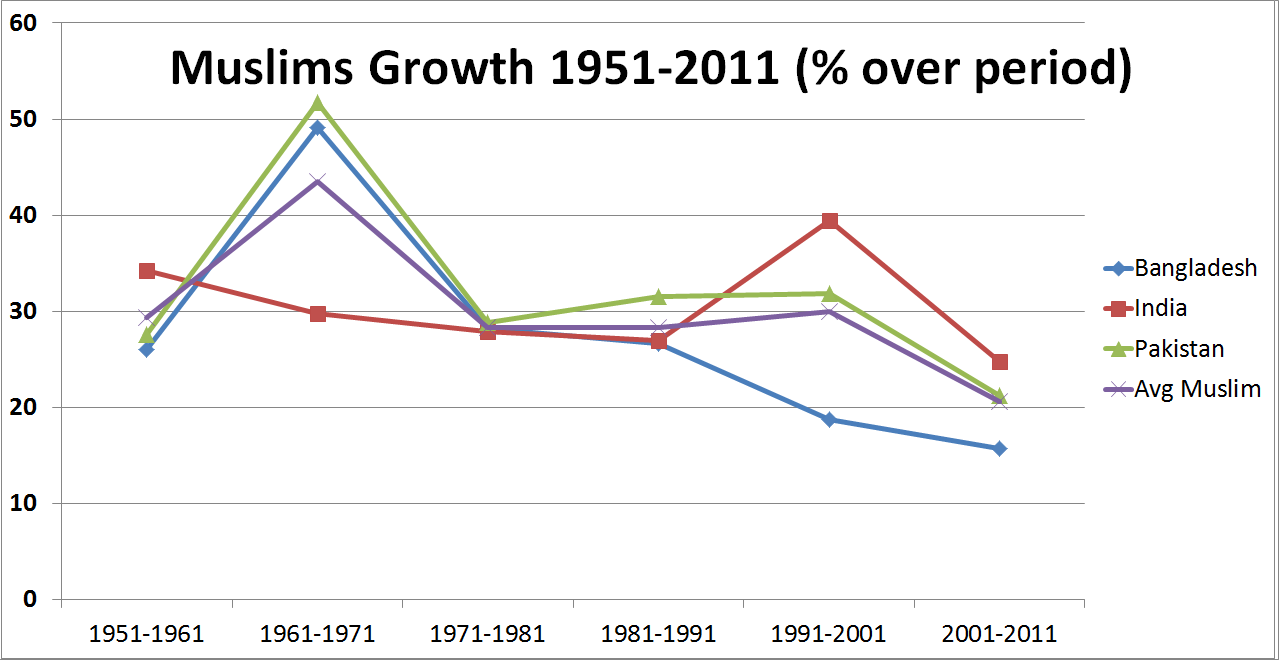
Following our exploration of regional demographic trends, this section expands the lens to the global stage, focusing on the Muslim population’s growth. Here, we connect cultural, religious, and migration patterns to broader socio-political dynamics, offering insights into how these trends influence global political landscapes and societal interactions.
The demographic shifts among Muslim populations globally have become a focal point for researchers and policymakers alike. As various reports and studies suggest, these shifts are driven by a combination of higher fertility rates, cultural and religious encouragement to have large families, and migration patterns. This section explores the impact of these demographic trends in different regions, including India, Europe, and the United States, and examines the socio-political implications of these changes.
Muslim Population Growth: Demographic Shift in India
The thesis posits a demographic shift where the Muslim population in India is growing at a significantly faster rate than the Hindu population. The Pew Research Center’s report supports this by projecting that India will have the largest Muslim population by 2050. The report indicates that the Muslim population in India will rise from 14.4% in 2010 to an estimated 18.4% in 2050. In contrast, the Hindu population, while still the majority, is expected to constitute approximately 76.7% of the population by 2050. This projection underscores the rapid growth of the Muslim population compared to the Hindu population. Historically, the Muslim population in India has grown by approximately 5.5 times since 1951, whereas the Hindu population has grown by about 3.5 times. This growth disparity contributes to a younger Muslim demographic, which can influence political dynamics due to their larger representation in the electorate over time. This demographic shift suggests a potential for increased political influence, particularly in democratic systems where voting patterns significantly impact governance.
Rapid Demographic Change in India
In the context of India, the growth of the Muslim population has been significantly higher compared to other communities. From 1951 to 2021, the Muslim population has grown 5.5 times, while the Hindu population has grown 3.6 times. This rapid growth is not solely due to economic conditions or lack of education, as evidenced by similar trends in countries like the UK, US, France, and Germany where economic and educational opportunities are more equitable. This suggests that cultural and religious factors play a critical role in the demographic growth of Muslim communities. The political landscape in India reflects these demographic changes, including Muslim Population Growth, with political parties often engaging in appeasement of Muslim communities for electoral gains. Examples of such appeasement include the development of madrasas, resistance to uniform civil codes, and funding for Hajj pilgrimages. These policies and practices indicate a concerted effort to maintain and grow the Muslim population for political leverage. The demographic shift towards a larger Muslim population has significant implications for India’s socio-political environment, potentially leading to increased political influence and shifts in policy focus.
Hijab Controversy in Karnataka: A Flashpoint in International Media Narrative on Radicalization
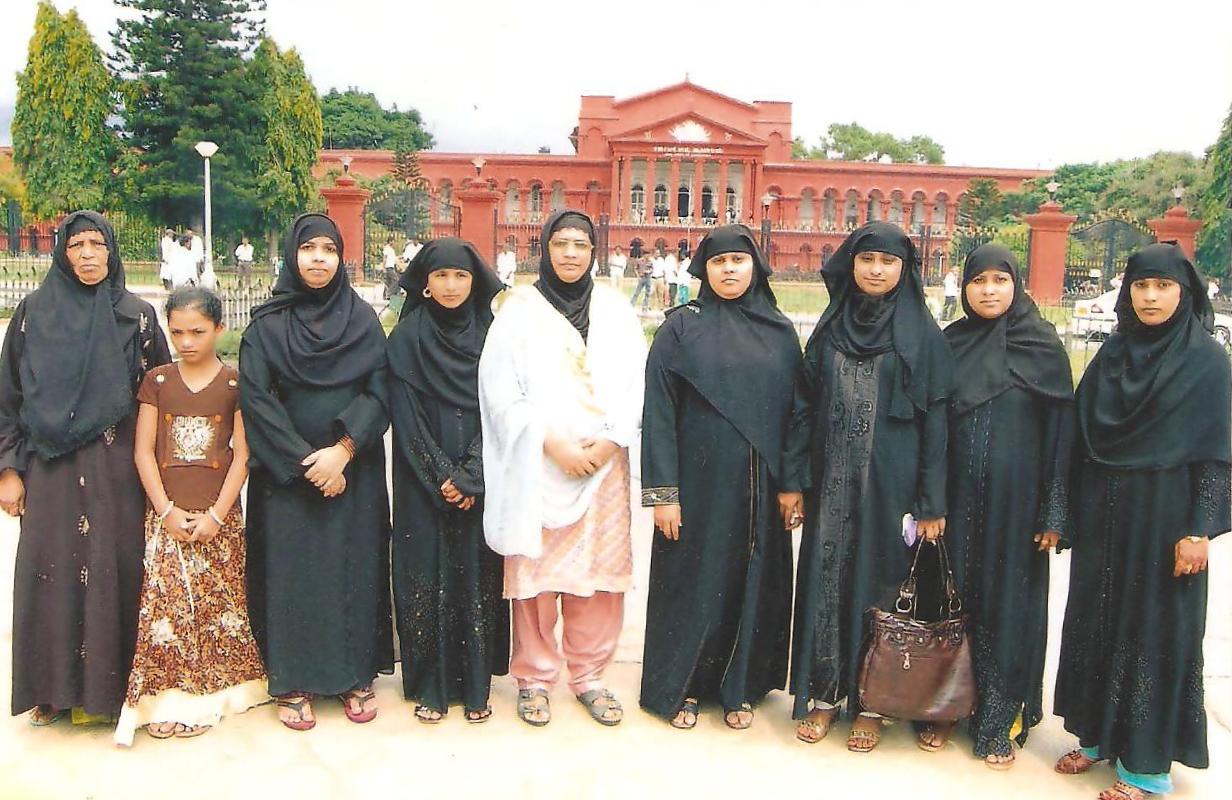
Comparative Insights
Global Demographic Trends: Analyzing Impact of Muslims and Islamic Practices on Global Population
Demographic Trends in Europe
The Pew Research Center’s analysis of Europe’s growing Muslim population reveals that Muslim women in Europe have a higher fertility rate (2.6 children per woman) compared to non-Muslim women (1.6 children per woman), contributing to significant Global Population Growth. This higher fertility rate, combined with sustained migration patterns, contributes to the growth of the Muslim population in Europe. The example of Sadiq Khan’s election as Mayor of London highlights the political impact of these demographic changes. Khan’s success is attributed to strong support from Muslim voters, demonstrating how demographic shifts can influence electoral outcomes. Furthermore, the response to events such as the Hamas attack on Israel on October 7, 2023, where there was widespread criticism of Israeli retaliation but limited condemnation of Hamas from Muslim leaders and nations, illustrates the complex interplay of demographic, political, and religious dynamics. These examples emphasize the potential for demographic changes to impact political landscapes and international relations.
Fertility Rates in Western Europe
The Population Reference Bureau’s report on fertility rates among Muslims in Western Europe highlights that Muslim women tend to have more children than non-Muslim women. This pattern is consistent with the broader global trend of higher fertility rates among Muslim populations. For instance, Muslim women in Western Europe have an average of 2.6 children compared to 1.6 children for non-Muslim women. This higher fertility rate, driven by religious and cultural encouragement to have large families, contributes significantly to the Population Growth Rates of the Muslim population in Europe. This demographic trend is reinforced by Islamic teachings that emphasize the importance of having many children, as reflected in various Quranic verses and hadiths. This ongoing demographic shift can influence the social and political landscapes in these regions, as larger Muslim communities can lead to greater political representation and influence.
Demographic Growth in the United States
In the United States, the Muslim population’s growth is also notable. As of 2011, the fertility rate for Muslims in the U.S. was estimated at 2.8 children per woman, contributing to substantial Population Projections for future growth. This trend is expected to continue, with the Pew Research Center projecting that the U.S. Muslim population will continue to grow, influenced by both higher fertility rates and migration patterns. This demographic growth aligns with broader global trends where the youthful population and higher birth rates among Muslims contribute to their population increase. The youthful demographic ensures a continuous cycle of population growth, which, coupled with migration, reinforces the presence and influence of the Muslim community in the U.S.
Continued Growth in the United States
The Pew Research Center’s 2018 estimates further underscore the continuing Muslim Population Growth in the U.S. By 2050, the Muslim population in the U.S. is projected to nearly double from its 2017 level, indicating a sustained trend of demographic increase driven by higher fertility rates and immigration patterns. This growth is part of broader Global Demographic Trends and reflects the natural demographic dynamics rather than any deliberate effort to alter population compositions. However, it is noteworthy that other immigrant groups, such as Hindus, Hispanics, or Chinese, do not exhibit the same rapid growth rate as Muslims in the U.S., suggesting that cultural or religious factors might be contributing to these demographic differences.
Summary Rationale for Population Growth
“This analysis of demographic trends within Muslim communities in Europe, the United States, and globally illustrates that cultural and religious factors play a significant role in influencing population growth. The higher fertility rates among Muslim women, supported by cultural norms and religious teachings that advocate for large families, are a pivotal factor driving the demographic changes observed in these regions. This trend is reinforced by various Islamic teachings which emphasize the virtue of large families, influencing population dynamics more significantly than socioeconomic factors alone. These demographic trends not only highlight the unique cultural and religious aspects of Muslim communities but also underscore the need for policies that consider these factors. Understanding these influences is crucial for addressing the challenges and opportunities presented by global demographic shifts, ensuring that strategies for social integration, resource management, and political engagement are informed by a comprehensive appreciation of cultural and religious contexts.
Role of Islamic Teachings in Population Growth
Cultural and Religious Encouragement
The cultural and religious encouragement to have large families is a significant factor in the rapid population growth among Muslims. Islamic teachings, as highlighted on platforms such as IslamQA, emphasize the importance of having many children. Several hadiths and Quranic verses encourage Muslims to marry and have large families, suggesting that increasing the number of followers is seen as a positive and desirable goal in Islam. For example, the Prophet Muhammad is reported to have said, “Marry the one who is loving and fertile, for I will be proud of your great numbers before all other nations on the Day of Judgment”. These teachings are deeply ingrained in the Muslim community and contribute to higher fertility rates, which in turn influence demographic trends globally.
Islamic Teachings on Family Size
Islamic teachings detailed on platforms like IslamQA encourage Muslims to have many children. The Prophet Muhammad’s advice to marry fertile partners and have numerous children underscores this cultural norm. Verses from the Quran, such as Surah 11:6 and Surah 17:31, emphasize that Allah will provide for all, discouraging the practice of limiting family size due to economic fears. This cultural emphasis on large families, combined with higher fertility rates among Muslim populations, leads to significant demographic growth. The teachings on family size are also reflected in the broader Islamic jurisprudence, which opposes limiting the number of children. This religious and cultural framework contributes to the sustained population growth observed among Muslim communities globally.
Religious Duty and Trust in Provision
Islamic teachings reinforce the idea that it is a religious duty to have many children and trust in Allah to provide for them. Verses from the Quran, such as Surah Al-Isra (17:31) and Surah Al-Ankabut (29:60), emphasize that Allah will provide for all living creatures, discouraging the practice of limiting family size due to economic concerns. This perspective is also supported by Islamic jurisprudence, which generally opposes limiting the number of children out of fear of poverty. This religious and cultural ethos encourages larger family sizes among Muslims, contributing to the rapid population growth observed in many Muslim communities around the world. Additionally, statements from groups like Hamas, which prioritize increasing the Muslim population as part of their broader ideological goals, reflect the intersection of demographic growth with political and religious strategies.
Impact of Islam on World Population
The analysis of global demographic trends reveals a significant and ongoing increase in the Muslim population, influenced by cultural, religious, and socio-economic factors. In India, the rapid growth of the Muslim population compared to other communities highlights the influence of cultural and religious values on family size. Similarly, in Europe and the United States, higher fertility rates and migration patterns contribute to the growing Muslim demographic, which in turn affects political landscapes and societal dynamics.
Understanding these trends, including Global Population Growth and Population Growth Rates, is crucial for developing informed policies that address the diverse needs of growing populations. It is important to move beyond simplistic narratives and acknowledge the complex interplay of factors driving demographic changes. By fostering inclusive and equitable approaches, societies can better navigate the challenges and opportunities presented by these demographic shifts, ensuring sustainable development and social harmony.
Understanding the Educational Advancements of Muslim Women
Economic Barriers vs. Religious Constraints
The Pew Research Center’s analysis provides compelling evidence that economic conditions, rather than Islamic doctrines, predominantly restrict the educational opportunities of Muslim women. This finding challenges the widespread narrative that Islam inherently limits women’s education—a narrative often fueled by the actions of extremist groups like Boko Haram or policies from the Taliban. The article underlines that in wealthier Islamic nations, when economic barriers are removed, Muslim women’s educational achievements are comparable to or exceed those of their male counterparts, illustrating the potential for education when economic impediments are mitigated.
Rethinking the Drivers of Demographic and Educational Trends
The interplay of cultural, religious, and economic factors in shaping the demographic and educational patterns among Muslims is multifaceted and complex. This discourse emphasizes the importance of looking beyond the simplistic attributions of religious doctrines as the sole drivers of these trends. Recognizing how economic limitations substantially impact these patterns is crucial for developing more comprehensive and effective policies. This understanding is essential for cultivating environments that support educational and demographic equity across diverse communities. This reevaluation also counters the narrative that fundamentalist ideologies overwhelmingly control Islamic practices, presenting a more balanced view where economic realities significantly influence educational and demographic outcomes. This nuanced understanding is critical for policymakers and societies committed to fostering sustainable development and social harmony globally.
Educational and Demographic Trends Among Muslims Globally
After examining the broader demographic trends and the impact of socio-economic factors on Muslim communities globally, it’s imperative to delve into the specific educational outcomes within these populations. This next section explores the educational attainment among Muslims, shedding light on how factors beyond mere religious beliefs—specifically economic circumstances—shape educational opportunities. By understanding these educational dynamics, we can further unravel the complex tapestry of factors influencing Muslim communities worldwide.
Formal Schooling Among Muslims Worldwide
This section explores the educational attainment among Muslims and non-Muslims across various global regions, highlighting the disparities and socio-economic influences shaping educational opportunities.
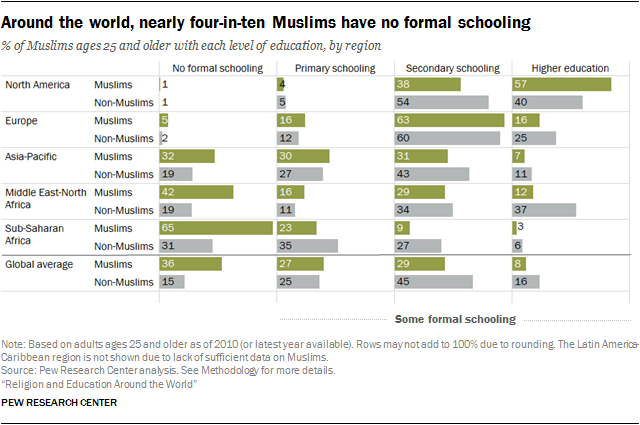
The graph displays the percentage of Muslims and non-Muslims aged 25 and older with no formal schooling, primary schooling, secondary schooling, and higher education across different regions including North America, Europe, Asia-Pacific, Middle East-North Africa, Sub-Saharan Africa, and global averages.”
The data reveals significant regional disparities in educational attainment, with a notable gap between Muslims and non-Muslims, particularly in regions like the Middle East-North Africa and Sub-Saharan Africa. This suggests that economic factors, rather than religious doctrines, predominantly influence these educational outcomes.
Educational Attainment in Countries with Significant Muslim Populations
This analysis highlights the average years of schooling for Muslims around the world, comparing regions where Muslims are a minority versus where they are a majority, and spotlighting countries with the largest Muslim populations.
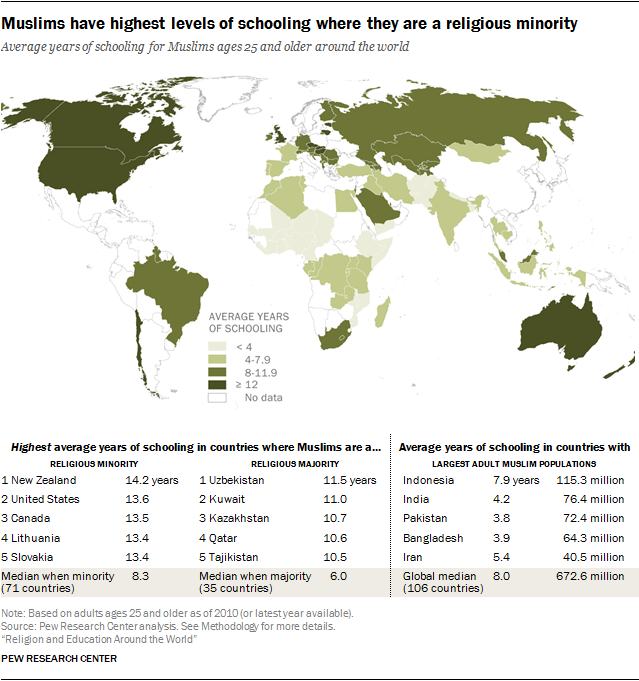
The map and accompanying statistics illustrate the average years of schooling for Muslims globally, differentiating between countries where Muslims are religious minorities and majorities. It includes specific country data like New Zealand, the United States, Uzbekistan, and Kuwait
Muslims tend to have higher educational attainment in countries where they are minorities, such as in New Zealand and the United States, compared to countries where they are majorities like Uzbekistan and Kuwait, indicating the influence of broader societal and economic environments on educational outcomes.
Gender Disparities in Education Among Muslims
This segment delves into the gender disparities in education within Muslim communities globally, revealing differences in the average years of schooling between Muslim men and women by region.
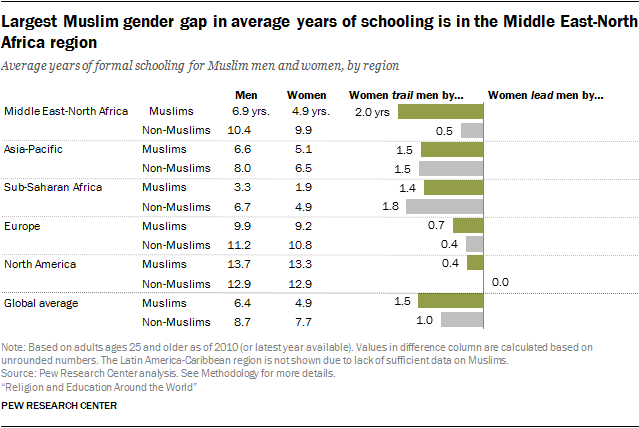
The chart compares the average years of formal schooling for Muslim men and women in various regions including Middle East-North Africa, Asia-Pacific, Sub-Saharan Africa, Europe, and North America, highlighting the gender gap in each area.
The chart demonstrates that gender disparities in education among Muslims vary significantly by region, with the largest gaps appearing in the Middle East-North Africa. This underscores the complex interplay of cultural, religious, and economic factors influencing educational access for Muslim women.
Comparative Analysis of Educational Levels
The diverse educational graphs analyzed highlight substantial regional and gender disparities within the global Muslim population, driven by a complex mix of socio-economic, cultural, and religious factors. These disparities underscore that socio-economic conditions alone do not dictate educational outcomes or fertility rates among Muslims. This insight challenges the conventional view that economic factors are the primary drivers of these trends. Instead, it emphasizes the need for policies that address the nuanced interplay of cultural and economic influences. This broader understanding is crucial for developing effective strategies that recognize the diverse factors influencing educational and demographic patterns globally.
Case Study: Fertility Rates in India
Fertility Rate Comparison Between Among Muslims and Lower Strata Hindus
This introduces the comparative analysis graph, providing context and emphasizing the significance of regional dynamics in understanding India’s demographic milestones.

Challenging Conventional Wisdom
Moving from historical growth patterns to the underlying causes, we now challenge the conventional wisdom that attributes demographic changes solely to socio-economic factors. By comparing Bangladesh and Pakistan with India.
While it’s often argued that socioeconomic factors are primary determinants of population growth, examining the comparative demographics of Bangladesh and Pakistan, as well as the fertility rates among different socio-economic and religious groups in India, challenges this perspective. Both Bangladesh and Pakistan started from similar socioeconomic conditions post-partition; however, their demographic trajectories have diverged significantly over the decades.
Comparative Analysis: Bangladesh vs. Pakistan
Bangladesh, despite being economically disadvantaged compared to Pakistan for many years, has achieved remarkable success in controlling its population growth. This success is attributed not only to socioeconomic advancements but also to effective governmental policies and a significant change in societal attitudes towards family planning. These factors indicate a complex interplay of socio-economic and cultural dynamics rather than purely economic determinants.
Debunking the Socioeconomic Paradigm
These examples from Bangladesh and India illustrate that while socioeconomic factors are undeniably influential, they do not solely dictate population growth trends. Cultural, educational, and personal values, along with policy interventions, are equally crucial in shaping demographic outcomes. This insight calls for a broader understanding of population control strategies, recognizing the significant influence of cultural and personal decision-making processes alongside economic conditions.
Navigating the Demographic Landscape
The milestone of India’s population reaching 1 billion in 2000 has served as a crucial reference point for understanding the nation’s demographic dynamics and world population dynamics at large. The significant growth of the Muslim population relative to the Hindu population and other communities, as highlighted in the recent report, underscores the complex factors influencing population trends, including cultural, religious, and socioeconomic elements.
Debates over demographic changes often ignite intense discussions, especially in politically charged environments. It is essential to approach these debates with a balanced perspective, recognizing that simplistic narratives like “population jihad” do not capture the nuanced realities of demographic shifts. Instead, a comprehensive analysis reveals that factors such as education, healthcare access, cultural practices, and policy interventions play pivotal roles in shaping population dynamics.
As India continues to evolve, it is imperative for policymakers and society to focus on inclusive growth that respects the diversity of its population. Addressing the basic causes of demographic changes such as improving access to education and healthcare across all communities will be vital in ensuring sustainable development and social harmony.
However, when a society has reasons beyond normal rationale to decide not to use the community education and other such facilities, it is difficult to change the situation as is applicable to a large community of Muslims in India and elsewhere in the world. Moreover, Islamic fundamentalism and fundamentalist interpretation of Islamic Tests is growing, presenting a worrisome picture of the world peace and population stability.
By fostering an environment where all communities can thrive, India can navigate its demographic landscape effectively, embracing its rich diversity as a strength rather than a source of division, in line with the World Population 2024 projections.
Feature Image: Click here to view the image.
#MuslimPopulationGrowth #GlobalDemographicTrends #PopulationGrowthRates #PopulationProjections #WorldPopulationStatistics #FertilityRates #DemographicShifts



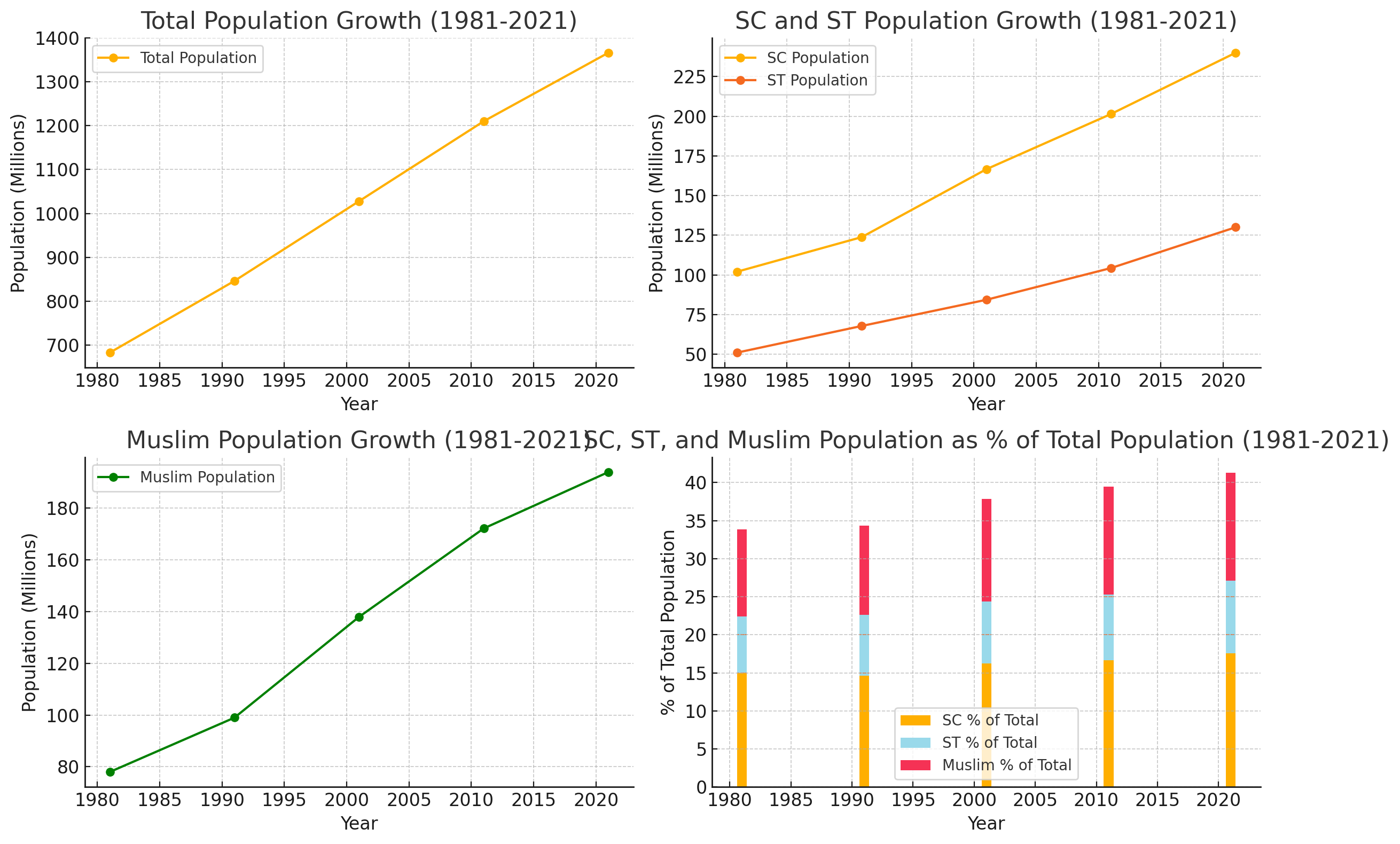
Leave a Reply